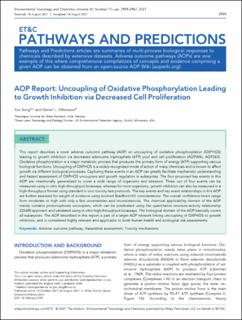| dc.contributor.author | Song, You | |
| dc.contributor.author | Villenueve, Daniel L. | |
| dc.date.accessioned | 2021-12-10T12:38:29Z | |
| dc.date.available | 2021-12-10T12:38:29Z | |
| dc.date.created | 2021-09-29T14:14:06Z | |
| dc.date.issued | 2021 | |
| dc.identifier.citation | Environmental Toxicology and Chemistry. 2021, 40 (11), 2959-2967. | en_US |
| dc.identifier.issn | 0730-7268 | |
| dc.identifier.uri | https://hdl.handle.net/11250/2833803 | |
| dc.description.abstract | This report describes a novel adverse outcome pathway (AOP) on uncoupling of oxidative phosphorylation (OXPHOS) leading to growth inhibition via decreased adenosine triphosphate (ATP) pool and cell proliferation (AOPWiki, AOP263). Oxidative phosphorylation is a major metabolic process that produces the primary form of energy (ATP) supporting various biological functions. Uncoupling of OXPHOS is a widely recognized mode of action of many chemicals and is known to affect growth via different biological processes. Capturing these events in an AOP can greatly facilitate mechanistic understanding and hazard assessment of OXPHOS uncouplers and growth regulators in eukaryotes. The four proposed key events in this AOP are intentionally generalized to cover a wide range of organisms and stressors. Three out of four events can be measured using in vitro high-throughput bioassays, whereas for most organisms, growth inhibition can also be measured in a high-throughput format using standard in vivo toxicity test protocols. The key events and key event relationships in this AOP are further assessed for weight of evidence using evolved Bradford-Hill considerations. The overall confidence levels range from moderate to high with only a few uncertainties and inconsistencies. The chemical applicability domain of the AOP mainly contains protonophores uncouplers, which can be predicated using the quantitative structure-activity relationship (QSAR) approach and validated using in vitro high-throughput bioassays. The biological domain of the AOP basically covers all eukaryotes. The AOP described in this report is part of a larger AOP network linking uncoupling of OXPHOS to growth inhibition, and is considered highly relevant and applicable to both human health and ecological risk assessments. | en_US |
| dc.language.iso | eng | en_US |
| dc.publisher | Wiley | en_US |
| dc.rights | Navngivelse 4.0 Internasjonal | * |
| dc.rights.uri | http://creativecommons.org/licenses/by/4.0/deed.no | * |
| dc.title | AOP Report: Uncoupling of Oxidative Phosphorylation Leading to Growth Inhibition via Decreased Cell Proliferation | en_US |
| dc.type | Peer reviewed | en_US |
| dc.type | Journal article | en_US |
| dc.description.version | publishedVersion | en_US |
| dc.rights.holder | © 2021 The Authors | en_US |
| dc.subject.nsi | VDP::Økotoksikologi: 489 | en_US |
| dc.subject.nsi | VDP::Eco-toxicology: 489 | en_US |
| dc.source.pagenumber | 2959-2967 | en_US |
| dc.source.volume | 40 | en_US |
| dc.source.journal | Environmental Toxicology and Chemistry | en_US |
| dc.source.issue | 11 | en_US |
| dc.identifier.doi | 10.1002/etc.5197 | |
| dc.identifier.cristin | 1940626 | |
| dc.relation.project | Norges forskningsråd: 301397 | en_US |
| cristin.ispublished | true | |
| cristin.fulltext | original | |
| cristin.qualitycode | 2 | |

